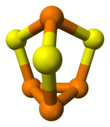| |||

| |||
| Names | |||
|---|---|---|---|
| IUPAC names
Tetraphosphorus trisulfide
or 3,5,7-trithia-1,2,4,6-tetraphosphatricyclo[2.2.1.02,6]heptane | |||
| Other names
phosphorus trisulfide, phosphorus sesquisulfide, phosphorus sulfide
| |||
| Identifiers | |||
3D model (JSmol)
|
|||
| ChemSpider | |||
| ECHA InfoCard | 100.013.860 | ||
PubChem CID
|
|||
| RTECS number |
| ||
| UNII | |||
CompTox Dashboard (EPA)
|
|||
| |||
| |||
| Properties | |||
| P4S3 | |||
| Molar mass | 220.093 g/mol | ||
| Appearance | Yellow, yellow-green or gray solid | ||
| Density | 2.08 g.cm3,[1] solid | ||
| Melting point | 172.5 °C (342.5 °F; 445.6 K) | ||
| Boiling point | 408 °C (766 °F; 681 K) | ||
| Structure | |||
| orthorhombic, Schönflies notation D2h | |||
| Pmnb | |||
| C3v | |||
| Related compounds | |||
Related compounds
|
P4S10 P4O6 | ||
| Hazards | |||
| Occupational safety and health (OHS/OSH): | |||
Main hazards
|
Irritant | ||
| GHS labelling: | |||

| |||
Except where otherwise noted, data are given for materials in their standard state (at 25 °C [77 °F], 100 kPa).
| |||
Phosphorus sesquisulfide is the inorganic compound with the formula P4S3. It was developed by Henri Sevene and Emile David Cahen in 1898 as part of their invention of friction matches that did not pose the health hazards of white phosphorus.[2][3] This yellow solid is one of two commercially produced phosphorus sulfides. It is a component of "strike anywhere" matches.
Depending on purity, samples can appear yellow-green to grey. The compound was discovered by G. Lemoine and first produced safely in commercial quantities in 1898 by Albright and Wilson. It dissolves in an equal weight of carbon disulfide (CS2), and in a 1:50 weight ratio of benzene. Unlike some other phosphorus sulfides, P4S3 is slow to hydrolyze and has a well-defined melting point.
- ^ Leung, Y. C.; Waser, J.; van Houten, S.; Vos, A.; Wiegers, G. A.; Wiebenga, E. H. (1957). "The Crystal Structure of P4S3". Acta Crystallographica. 10 (9): 574–582. doi:10.1107/S0365110X57002042.
- ^ US patent 614350, Seyene, H.; Cahen, E. D., "Match Composition", issued 1898-11-15
- ^ US 614350

